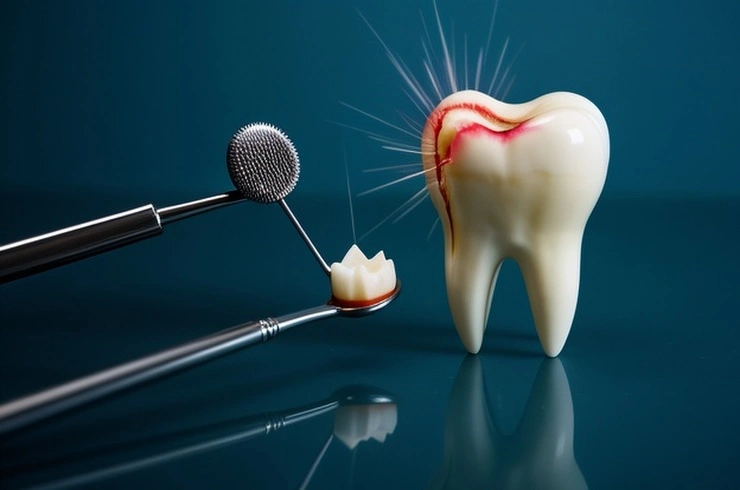
Your teeth, those essential tools for eating and speaking, owe much of their strength to a remarkable substance called enamel. This incredibly tough, translucent outer layer is the hardest tissue in your entire body, forming a protective shield over the visible part of your tooth, the crown. While enamel itself is translucent, the color of your teeth—whether bright white, off-white, or even yellowish—is primarily determined by the underlying dentin.
Enamel is your teeth's first line of defense against the constant wear and tear of daily life, from chewing and biting to grinding. It also acts as an insulator, protecting the sensitive inner parts of your teeth from extreme temperatures and harsh chemicals. However, despite its impressive durability, enamel isn't invincible. It can chip, crack, and, most commonly, erode. Unlike a broken bone, which the body can heal, damaged enamel cannot regenerate. This is because enamel lacks living cells, meaning any chips or cracks are permanent.
The Silent Threat: Enamel Erosion
Enamel erosion occurs when acids wear away this protective layer. Several factors can contribute to this acidic attack:
Dietary Choices: Frequent consumption of highly acidic foods and drinks is a major culprit. Think soft drinks, fruit juices (some of which are surprisingly more erosive than battery acid!), sour candies, and foods high in sugar and starches. The bacteria in your mouth feast on sugar, producing acids that directly attack enamel.
Oral Health Habits: Infrequent or inadequate brushing allows bacteria and their acid byproducts to accumulate, accelerating enamel breakdown.
Medical Conditions:
Dry Mouth (Xerostomia): Saliva plays a crucial role in neutralizing acids and washing away food particles and bacteria. Low saliva flow leaves your teeth vulnerable.
Acid Reflux Disease (GERD) and Heartburn: These conditions bring stomach acids up into the mouth, where they can severely damage enamel.
Gastrointestinal Problems: Certain digestive issues can contribute to an acidic oral environment.
Medications: Some medications, such as antihistamines, aspirin, and vitamin C, can increase acidity in the mouth.
Behavioral Factors:
Alcohol Misuse or Binge Drinking: Frequent vomiting associated with these conditions exposes teeth to highly corrosive stomach acids.
Bulimia: This eating disorder involves repeated vomiting, leading to significant enamel erosion and increased cavity risk.
Genetics: Some individuals may have an inherited predisposition to enamel issues.
Environmental Factors: Beyond diet and health, mechanical forces can also contribute to enamel loss:
Attrition: This is the natural wear from tooth-on-tooth friction, often seen in individuals who clench or grind their teeth (bruxism).
Abrasion: Physical wear from aggressive brushing, improper flossing, biting on hard objects (like pens or fingernails), or chewing tobacco.
Abfraction: Stress fractures in the tooth caused by flexing or bending.
Corrosion: Chemical erosion from direct contact with acidic substances, including certain medications or highly acidic foods.
Recognizing the Warning Signs
Enamel erosion often progresses subtly, but there are distinct signs to watch for:
Sensitivity: Early stages may present as a twinge of pain when consuming sweets or hot/cold foods and drinks.
Discoloration: As enamel thins and more dentin is exposed, teeth can appear yellowish.
Cracks and Chips: The edges of your teeth may become rough, irregular, or jagged.
Smooth, Shiny Surfaces: A sign of mineral loss, giving the teeth an unusually smooth, almost glass-like appearance.
Severe Painful Sensitivity: In advanced stages, even slight temperature changes or sweets can cause intense, sharp pain.
Cupping: Indentations may appear on the chewing surfaces of your teeth.
When enamel erodes, your teeth become far more susceptible to cavities. A small cavity can quickly grow, penetrating the tooth and potentially reaching the sensitive nerve fibers, leading to excruciating pain and infection.
Safeguarding Your Smile: Preventing Enamel Loss
Protecting your enamel is crucial for lifelong dental health. Here's how:
Maintain Excellent Oral Hygiene: Brush, floss, and rinse with a fluoride and antiseptic mouthwash daily. Regular dental checkups and cleanings every six months are vital.
Moderate Acidic Intake: Limit highly acidic foods and drinks like sodas, citrus fruits, and juices. If you do consume them, try to do so during mealtimes to minimize enamel exposure, and rinse your mouth immediately with plain water afterward. Consider using a straw for acidic beverages to direct the liquid away from your teeth.
Smart Snacking: Frequent snacking keeps your mouth acidic for longer periods, increasing decay risk. If you must snack, rinse your mouth or brush afterward.
Boost Saliva Production: Chewing sugar-free gum (especially with xylitol) between meals can significantly increase saliva flow, helping to neutralize acids and remineralize teeth. If you suffer from dry mouth, drink more water throughout the day.
Choose Fluoride Products: Use fluoride toothpaste, as fluoride strengthens enamel.
Gentle Brushing: Use a soft-bristled toothbrush and avoid aggressive brushing. Wait at least an hour to brush after consuming acidic foods or drinks, as enamel is temporarily softened and more vulnerable.
Consult Your Dentist: Discuss options like dental sealants to protect your teeth.
Address Underlying Health Conditions: Seek treatment for conditions like bulimia, alcoholism, or GERD, as they significantly impact oral health.
While fluoride is a beneficial ally against decay, excessive fluoride intake, particularly in children, can lead to enamel fluorosis, causing cosmetic defects in the enamel. Most cases are mild, but severe fluorosis can result in discolored and pitted teeth.
Treating Enamel Loss
The approach to treating enamel loss depends on its severity. For minor erosion, tooth bonding can protect the tooth and improve its appearance. If the loss is significant, your dentist may recommend covering the tooth with a crown or veneer to protect it from further decay and restore its function.
Pro Tip
The content of the article is shared by netizens, please carefully identify it